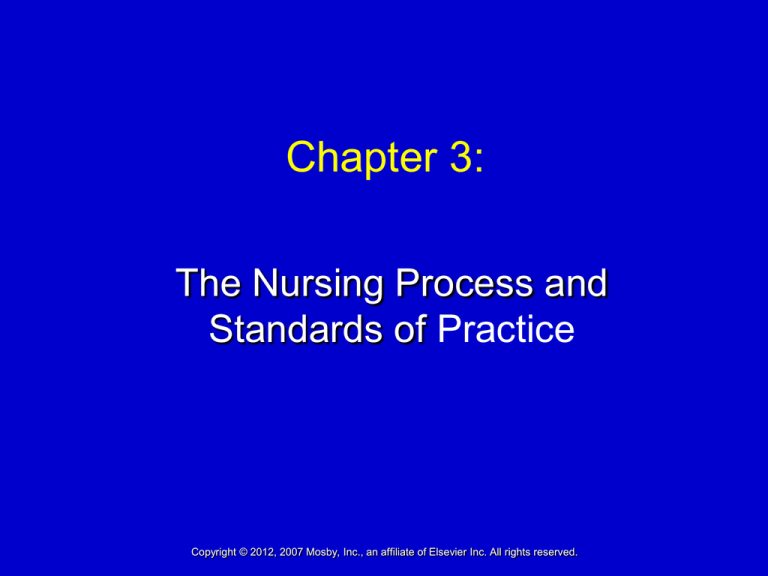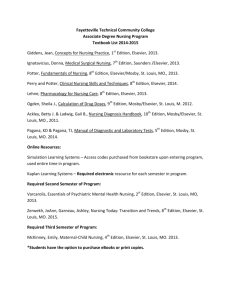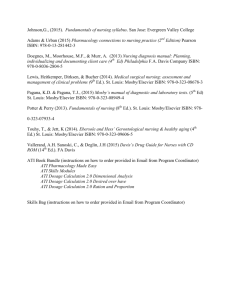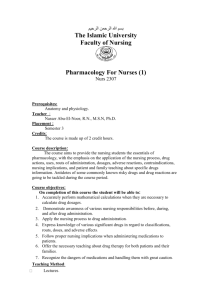
Chapter 3:
The Nursing Process and
Standards of Practice
Copyright © 2012, 2007 Mosby, Inc., an affiliate of Elsevier Inc. All rights reserved.
Standards of Practice and the
Steps of the Nursing Process
Standard I: Assessment
Standard II: Nursing diagnosis
Standard III: Outcome identification
Standard IV: Implementation
Standard V: Evaluation
Copyright © 2012, 2007 Mosby, Inc., an affiliate of Elsevier Inc. All rights reserved.
2
Characteristics of the
Nursing Process
Six-step, organized, problem solving method
unique to nursing
Designed to meet the needs of the patient,
family, community, and the environment
A universal language that acts as a common
thread to nursing
Copyright © 2012, 2007 Mosby, Inc., an affiliate of Elsevier Inc. All rights reserved.
3
Characteristics of the
Nursing Process, cont’d
Not linear: steps may not be sequential
Research methods that promote evidence
based standards of practice
Common language and body of knowledge
universally accepted by medical, nursing, and
other health care professionals
Copyright © 2012, 2007 Mosby, Inc., an affiliate of Elsevier Inc. All rights reserved.
4
Steps of the Nursing Process
1.
2.
3.
4.
5.
6.
Assessment
Nursing diagnosis
Outcome identification
Planning
Implementation (interventions)
Evaluation
Copyright © 2012, 2007 Mosby, Inc., an affiliate of Elsevier Inc. All rights reserved.
5
Figure 3-1 Cyclic nature of the nursing process and standards of care.
Copyright © 2012, 2007 Mosby, Inc., an affiliate of Elsevier Inc. All rights reserved.
6
Standards of Practice in Mental
Health Nursing
Developed by the American Nurses Association
(ANA), the American Psychiatric Nurses
Association, and the International Society of
Psychiatric-Mental Health Nurses (American
Nurses Association 2007)
Describes professional activities the nurse
performs during the steps of the nursing
process as they apply to mental health nursing
Copyright © 2012, 2007 Mosby, Inc., an affiliate of Elsevier Inc. All rights reserved.
7
Standard I. Assessment
The nurses assesses the patient’s mental
status, psychosocial state, physical health,
pain level, and nonverbal behaviors with the
use of various methods of data collection
Mental status examination (MSE) and
psychosocial assessment
Subjective: what the patient states
Objective: what is observed
Copyright © 2012, 2007 Mosby, Inc., an affiliate of Elsevier Inc. All rights reserved.
8
Nurse as Primary Communicator
Nurse is primary “tool”
Identifies patient strengths and problems
Requires knowledge of:
Psychodynamics
Psychopathology
Communication skills for rapport and support
Patient uniqueness
Copyright © 2012, 2007 Mosby, Inc., an affiliate of Elsevier Inc. All rights reserved.
9
Special Issues Related to
Assessment
Managed care
HIPAA privacy protection
Intuitive reasoning
Expertise
Critical thinking
Assessment settings
Assessment sources
Assessment rating scales
Copyright © 2012, 2007 Mosby, Inc., an affiliate of Elsevier Inc. All rights reserved.
10
Standard II. Nursing Diagnosis
Subjective
Objective
Actual
Potential
Reflects biologic, psychologic, sociocultural,
developmental, religious, spiritual, or sexual
process
Copyright © 2012, 2007 Mosby, Inc., an affiliate of Elsevier Inc. All rights reserved.
11
Mental Disorders: Diagnostic and
Statistic Manual of Mental
Disorders
Axis I: Psychiatric diagnosis
Axis II: Personality disorder or mental
retardation
Axis III: Medical diagnosis
Axis IV: Psychosocial stressors
Axis V: Global assessment of functioning
Copyright © 2012, 2007 Mosby, Inc., an affiliate of Elsevier Inc. All rights reserved.
12
Actual and Potential
Nursing Diagnoses
An actual problem nursing diagnosis consists
of:
Problem or need
Etiology
Defining characteristics
A potential problem (risk) nursing diagnosis
consists of:
Risk diagnosis
Risk factors as supporting factors; no etiology
Copyright © 2012, 2007 Mosby, Inc., an affiliate of Elsevier Inc. All rights reserved.
13
Figure 3-2 Nursing process depicting an actual diagnosis and a risk diagnosis
format of the six-step process.
Copyright © 2012, 2007 Mosby, Inc., an affiliate of Elsevier Inc. All rights reserved.
14
Standard III. Outcome
Identification
Outcomes are:
Specific, measurable indicators
Derived from nursing diagnoses
Projections of expected influence of nursing
interventions
Opposite of defining characteristics
Often put in patient’s own words
Copyright © 2012, 2007 Mosby, Inc., an affiliate of Elsevier Inc. All rights reserved.
15
Outcomes/Behavioral Goals
Observable
Measureable
Realistic
Ensure quality care
Justify reimbursement
Nursing Outcomes Classification (NOC) identifies outcomes most influenced by
nursing actions.
Copyright © 2012, 2007 Mosby, Inc., an affiliate of Elsevier Inc. All rights reserved.
16
Nursing Outcomes Classification
First standardized language describing
patient outcomes that are most responsive to
nursing care or most influenced by the
actions and interventions of nurses
Rated on a 5-point continuum (1 to 5)
Copyright © 2012, 2007 Mosby, Inc., an affiliate of Elsevier Inc. All rights reserved.
17
Standard IV. Planning
Collaboration with the patient, physician,
significant others, and interdisciplinary team
Identification of priorities of care
Coordination and delegation of
responsibilities of treatment team based on
expertise as related to patient ‘s needs
Critical decisions regarding interventions
related to evidence based practice (EBP)
Copyright © 2012, 2007 Mosby, Inc., an affiliate of Elsevier Inc. All rights reserved.
18
Evidenced Based Practice
Clinical pathways
Pathway variances
Concept mapping
Copyright © 2012, 2007 Mosby, Inc., an affiliate of Elsevier Inc. All rights reserved.
19
Concept Mapping
A type of algorithm or critical problem-solving plan
Means to organize all elements of care
Breaks down complex, relevant data into
manageable pieces to clarify the situation as a
whole
Helps to make connections between concepts
Copyright © 2012, 2007 Mosby, Inc., an affiliate of Elsevier Inc. All rights reserved.
20
Standard V. Implementation
Perform prescribed interventions
Copyright © 2012, 2007 Mosby, Inc., an affiliate of Elsevier Inc. All rights reserved.
21
Nursing Orders/Nursing
Prescriptions
Select to:
Achieve client outcomes
Prevent/reduce problems
Prescribe a course of action
Focus on modifying etiology
Rationales are rarely written but are often
discussed in multidisciplinary team meetings.
Copyright © 2012, 2007 Mosby, Inc., an affiliate of Elsevier Inc. All rights reserved.
22
Nursing Interventions
Classification
Facilitates the capture of certain nursing
activities and analysis of their impact on client
outcomes.
NIC interventions are linked to NOC
outcomes.
Copyright © 2012, 2007 Mosby, Inc., an affiliate of Elsevier Inc. All rights reserved.
23
Standard VI. Evaluation
Compare client current state/condition with
outcome criteria.
2. Consider all possible reasons why outcomes
are not achieved, should that be the case.
3. Make specific recommendations based on
conclusions drawn.
1.
Copyright © 2012, 2007 Mosby, Inc., an affiliate of Elsevier Inc. All rights reserved.
24
Documentation
“7th Standard of Care”
Problem-oriented SOAP or DAR charting
Subjective, Objective, Assessment, Planning,
Data, Analysis, Response
Copyright © 2012, 2007 Mosby, Inc., an affiliate of Elsevier Inc. All rights reserved.
25






